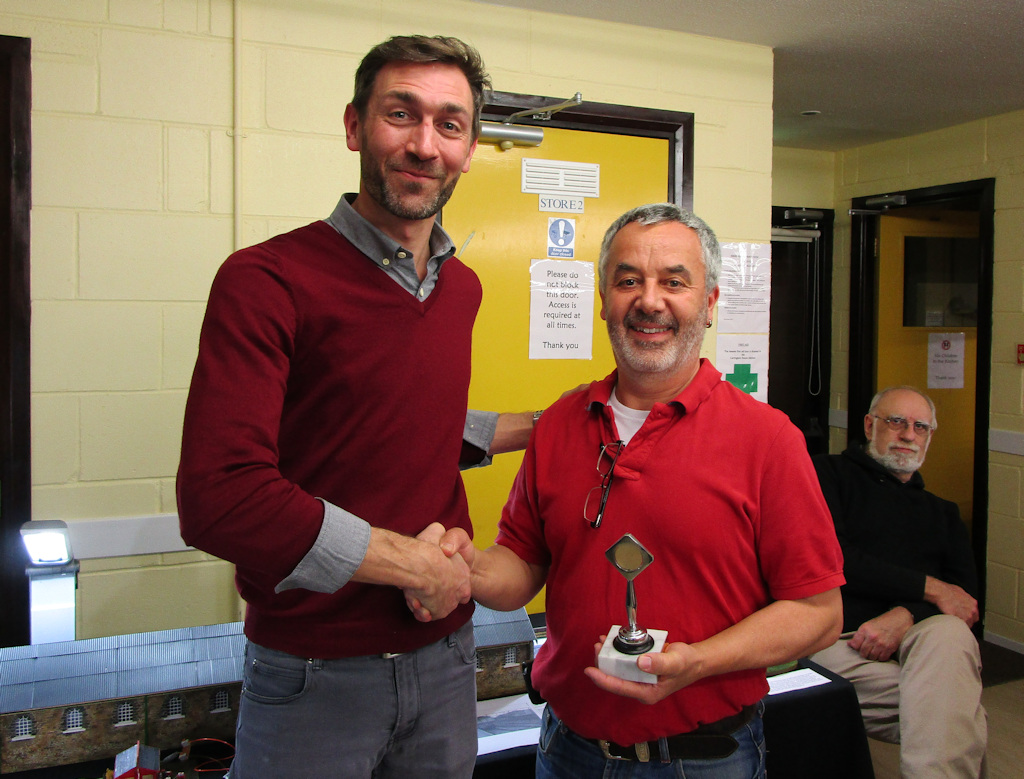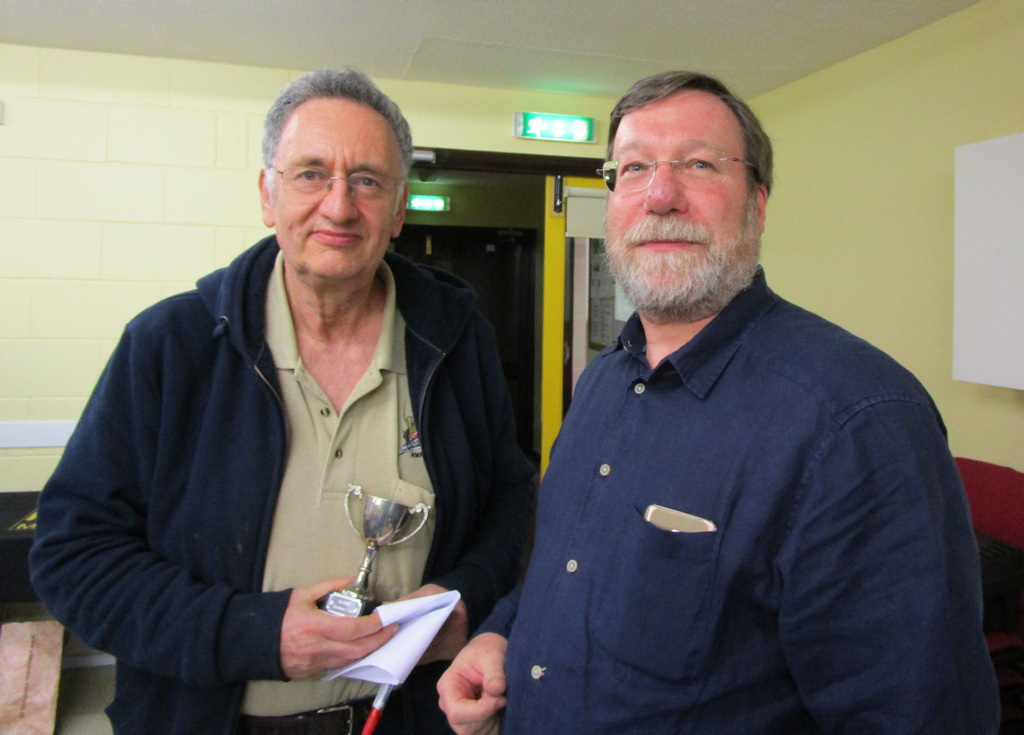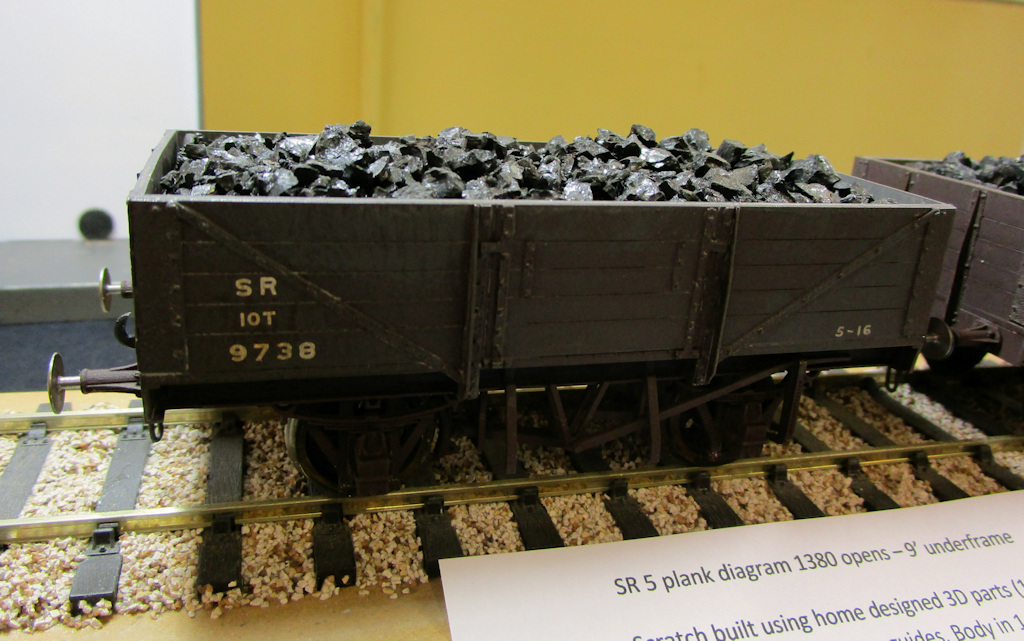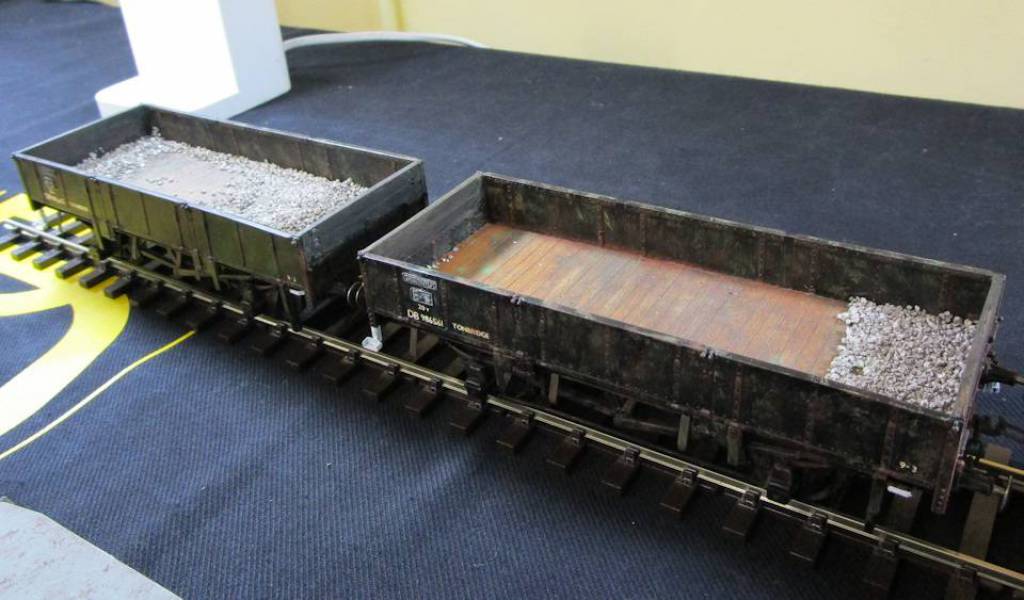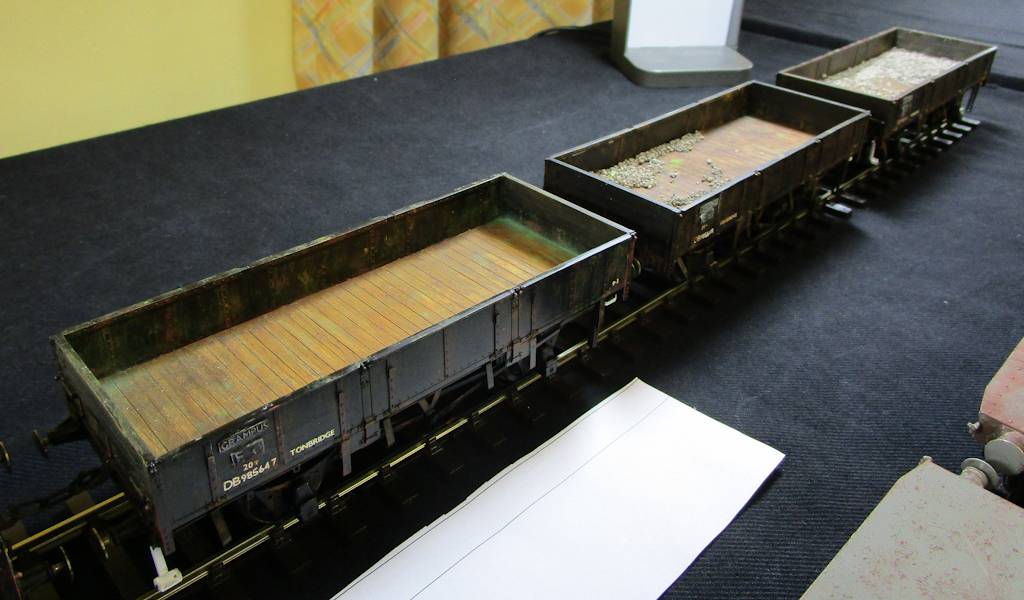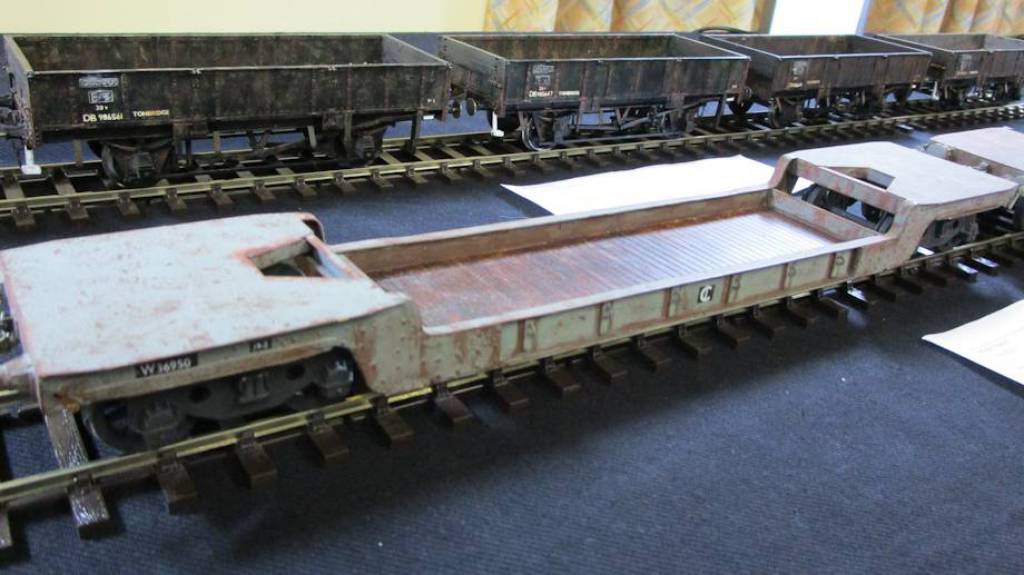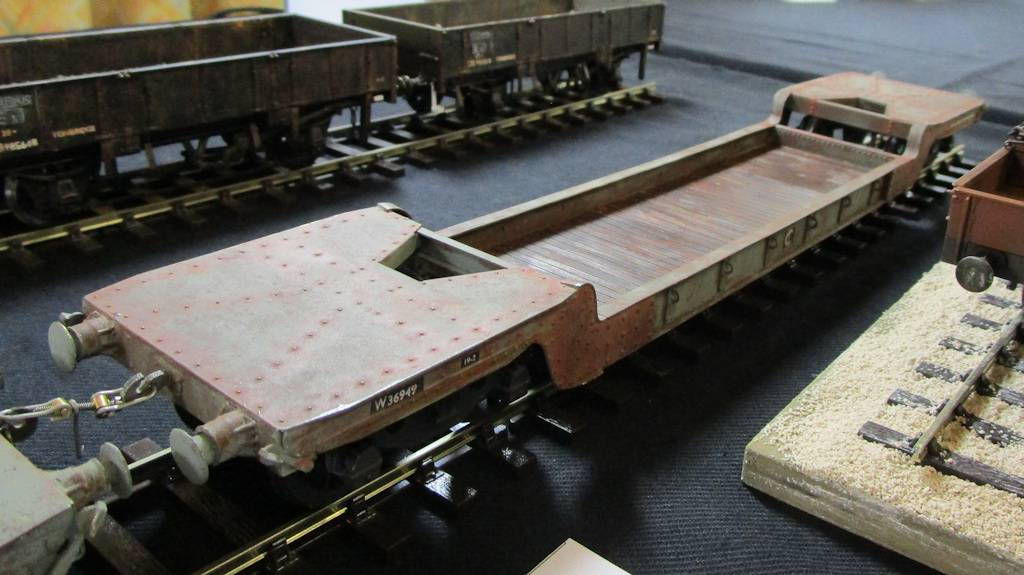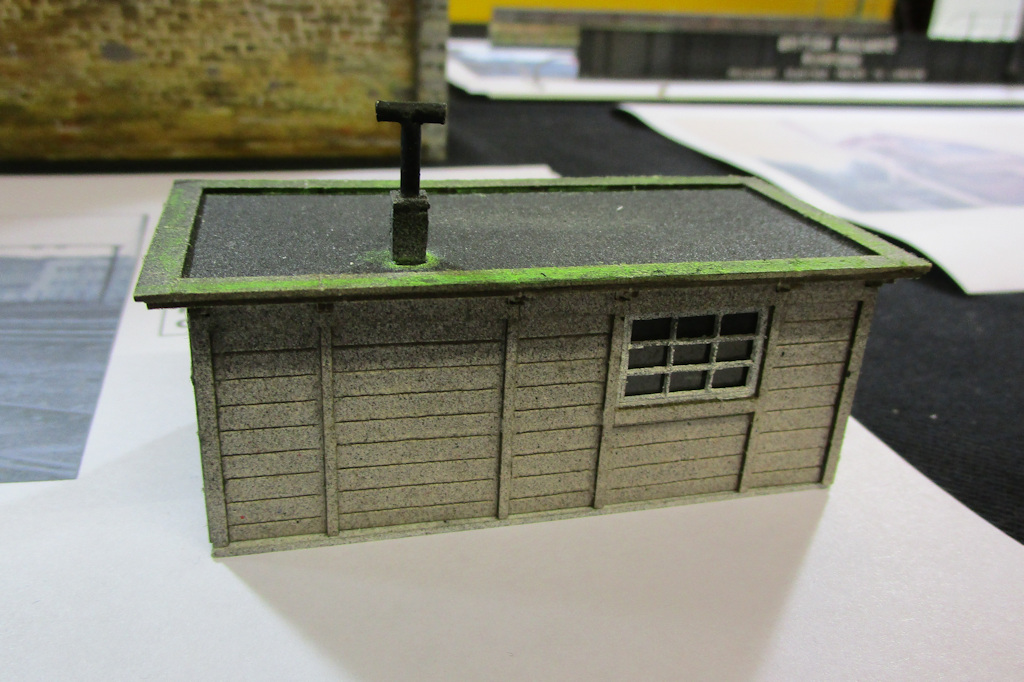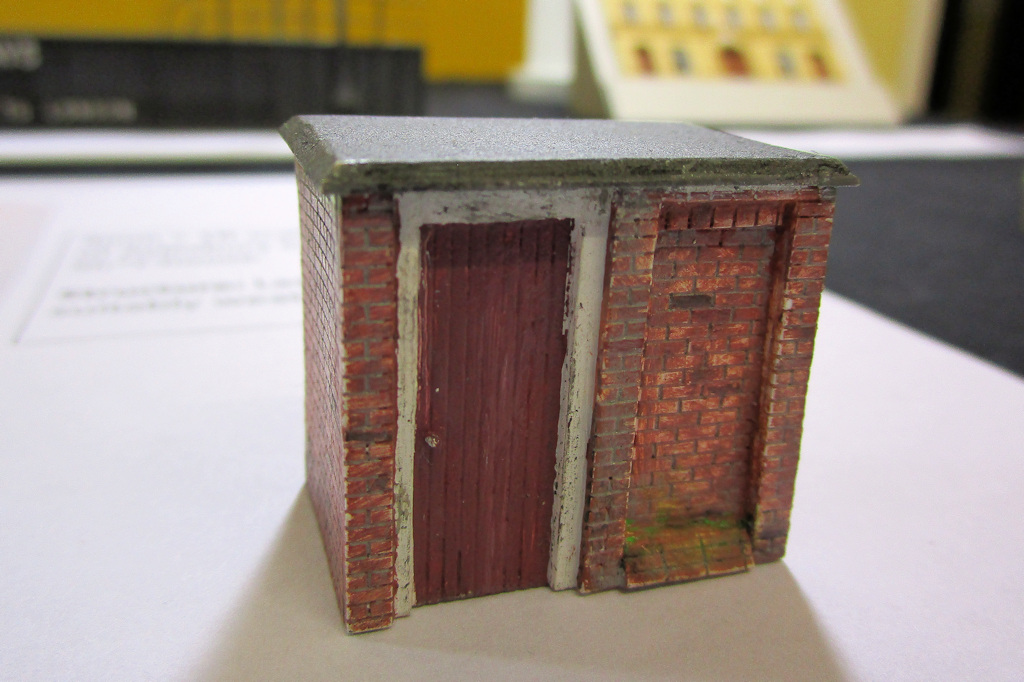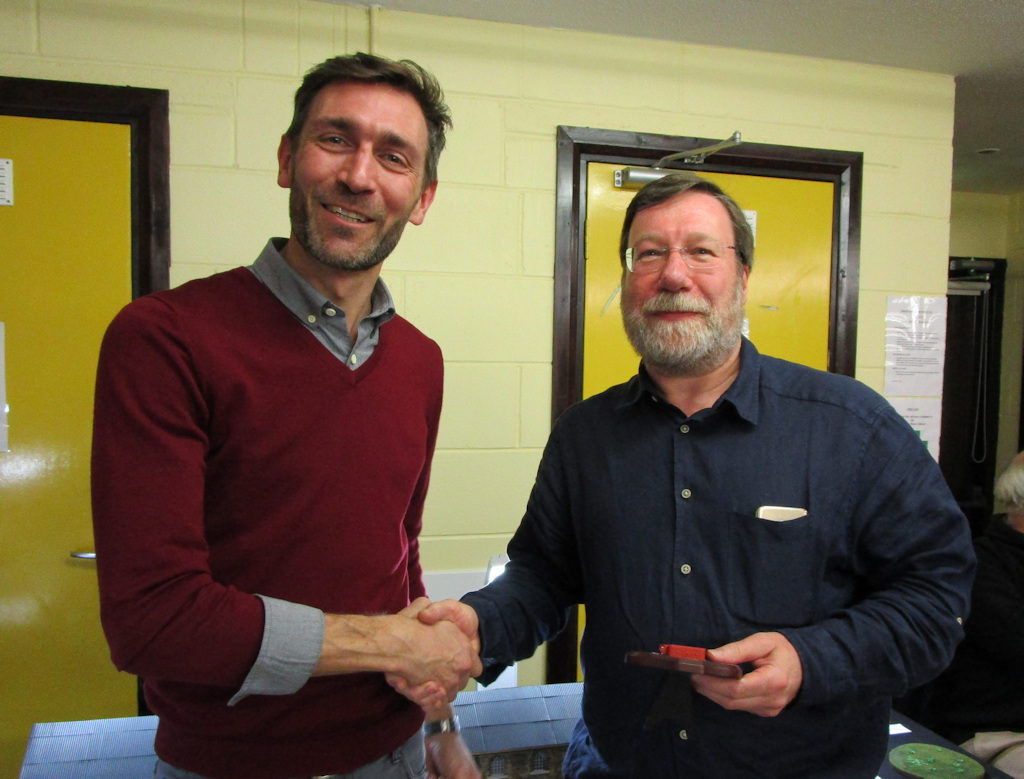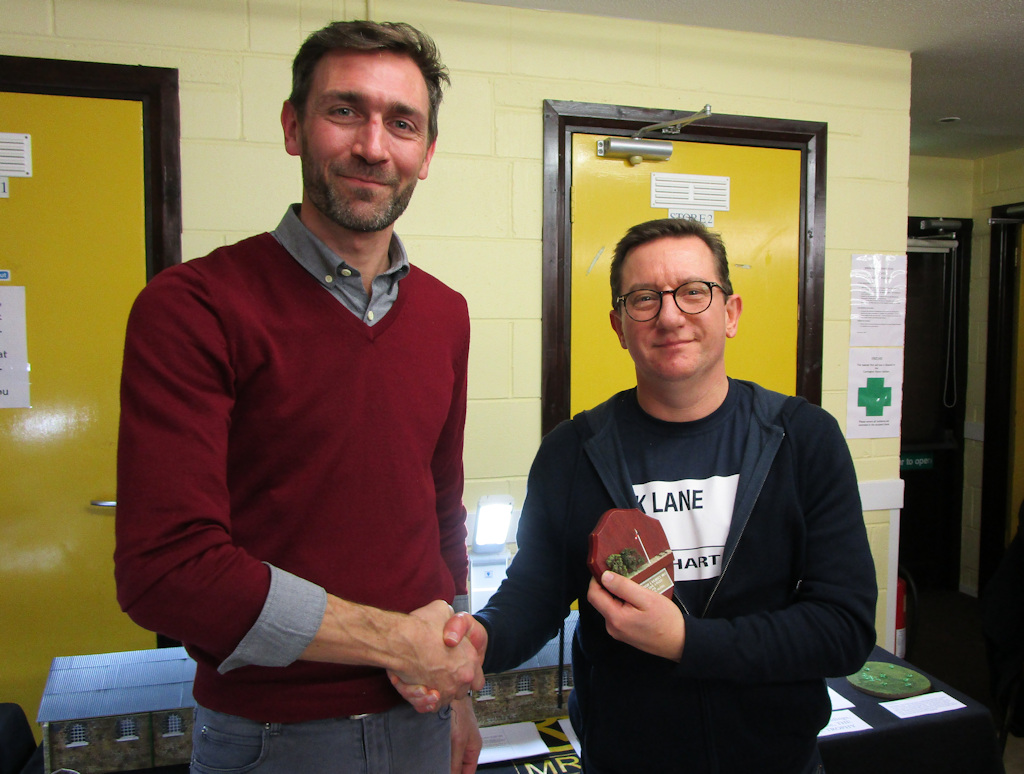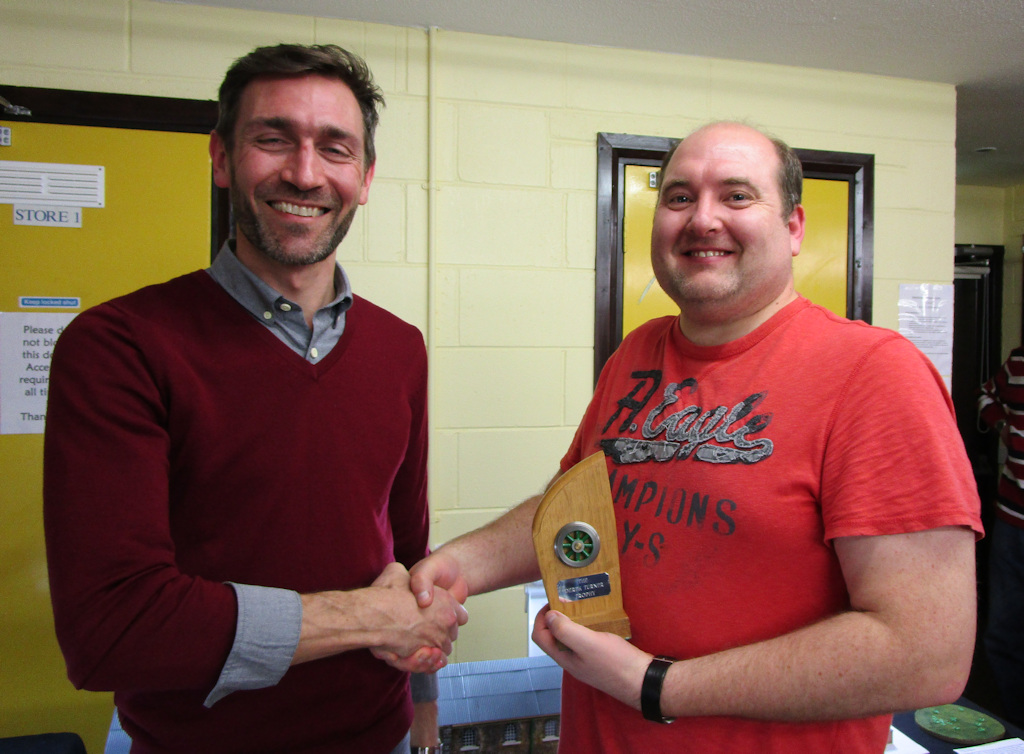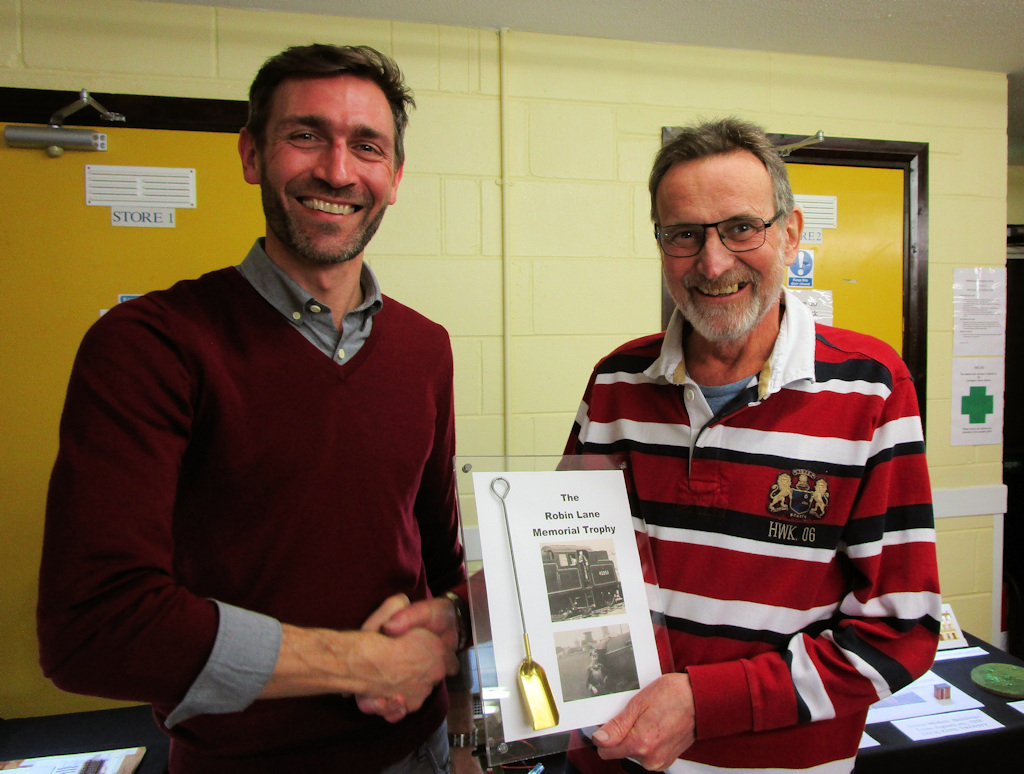Sidebar
Wheeltapper Competition 2017
Wheeltapper 2017 Competition took place on Friday the 10th of March when invited guest judge and speaker Alan Buttler from Modelu, came along to Judge the models on show and then to come up with the overall winner. On the night he gave an interesting talk on current developments in 3D printing technologies and how he uses it to produce exquisite scale models. For more details on Modelu visit Modelu3D
Wheeltapper Trophy
Alan presented the Wheeltapper trophy for the best model out of all the rolling stock categories to James Aitken (right) for his 7mm/ft O gauge model of SR Standard Van with uneven planks on a 10' underframe.
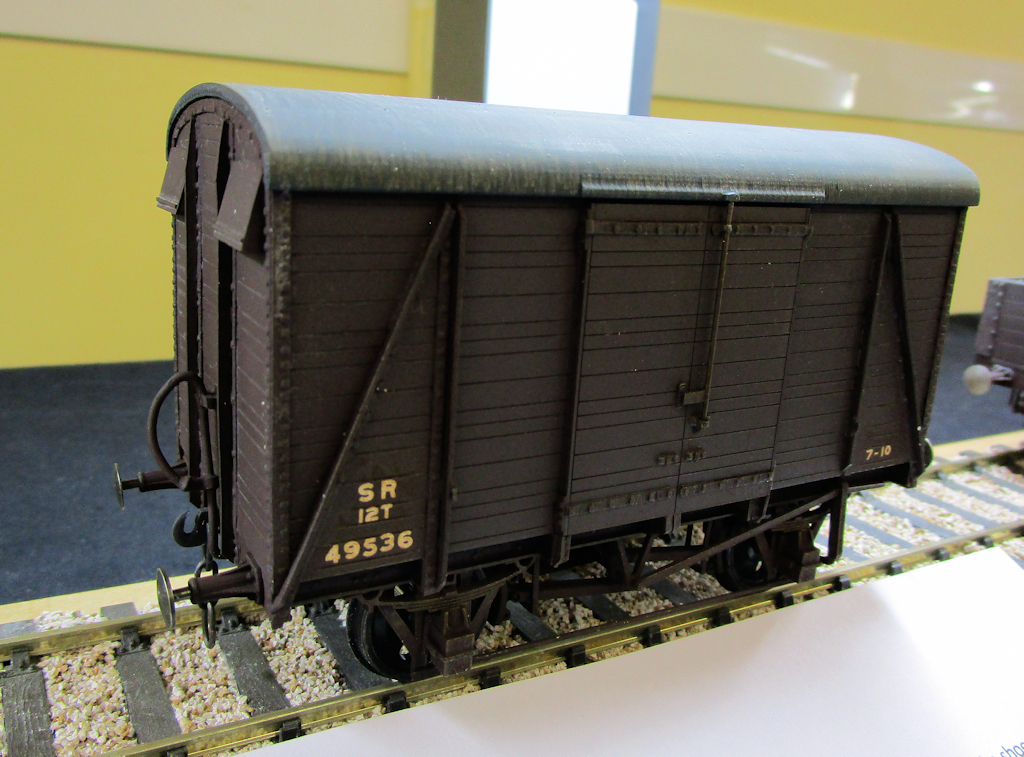 James’s model has been scratch built using home designed 3D parts - roof, vacuum cylinders, axle boxes, brake shoes, buffer housings and brake lever guides. Body parts were designed using CAD and cut using the club laser cutter. Main body sides and W irons in 1mm, ends, doors and spring assemblies in 1.5 mm, underframe in 0.8mm, strapping and vertical stanchions in 0.5mm plastic. The only commercial parts are the wheels and buffer heads. This model was also the winner in the Freight and Engineers Stock category.
James’s model has been scratch built using home designed 3D parts - roof, vacuum cylinders, axle boxes, brake shoes, buffer housings and brake lever guides. Body parts were designed using CAD and cut using the club laser cutter. Main body sides and W irons in 1mm, ends, doors and spring assemblies in 1.5 mm, underframe in 0.8mm, strapping and vertical stanchions in 0.5mm plastic. The only commercial parts are the wheels and buffer heads. This model was also the winner in the Freight and Engineers Stock category.
Chairman’s Cup
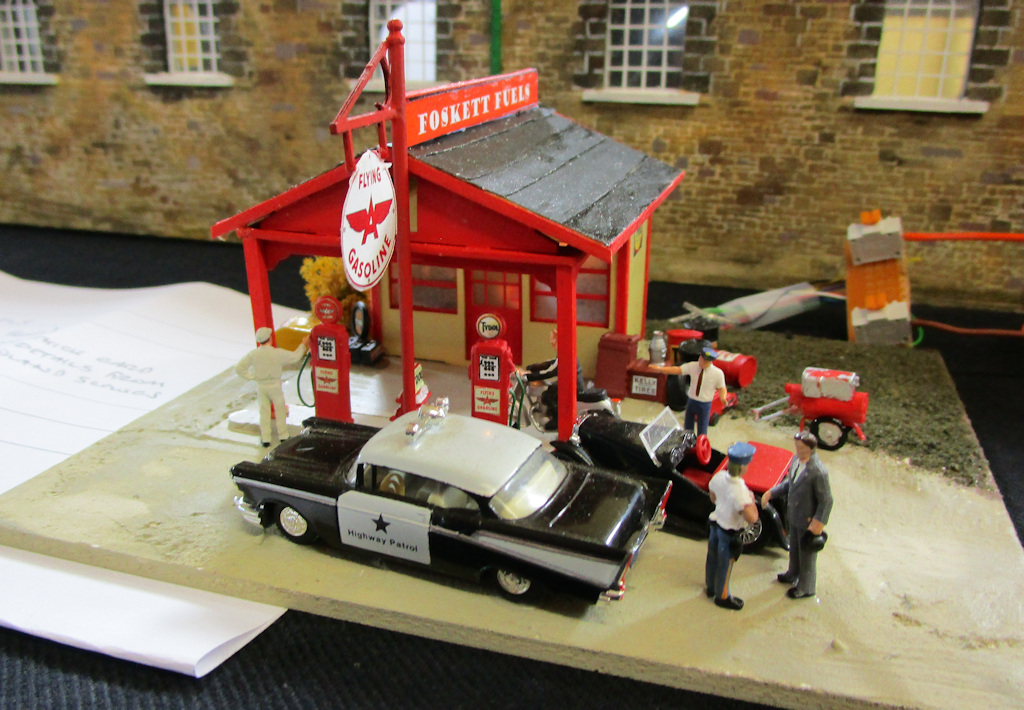 Ted’s model is a HO Scale (3.5mm to Foot) model of a roadside fuel garage. The model is simple laser cut thick card produced by David Pauuan. Detailing has been added from J.L. Innovation Design, Preiser, Woodland Scenics, and the lights are 1.5V.
Ted’s model is a HO Scale (3.5mm to Foot) model of a roadside fuel garage. The model is simple laser cut thick card produced by David Pauuan. Detailing has been added from J.L. Innovation Design, Preiser, Woodland Scenics, and the lights are 1.5V.
Steam Locomotives
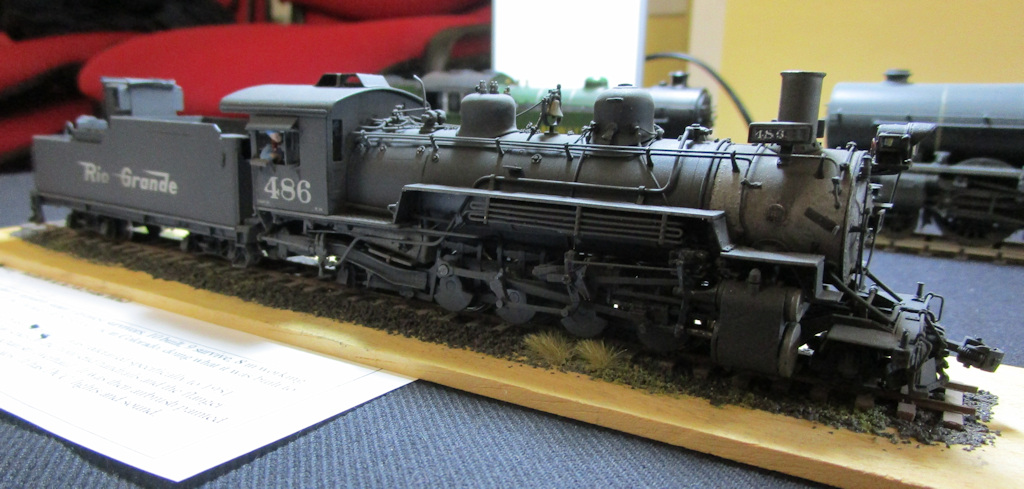 The winner of the Steam Locomotives competition was Mick Moignard for his D&RGW K-36 2-6-2 #486 HOn3. The K-36 class or arguably steam's greatest survivors, 10 built, 9 survive, 8 in working order today. #486 can be found on the Durango & Silverton line in Colorado, doing what it was built to do, haul long trains up steep grades. The model is an Overland Models unpainted brass offering. it was re-detailed specifically to 1951 condition with over 50 small changes including ball-ends on the front-end handrails and the flanger tell-tale up the smokebox from as well as a complete mechanism overhaul. It was then airbrush painted and lettered to suit, and weathered according to available photos. It has DCC, light and sound, including a smokebox mounted speaker and a chuff sync cam. It is in HOn3 scale: HO scale, 3 foot gauge, running on 10.5mm track.
The winner of the Steam Locomotives competition was Mick Moignard for his D&RGW K-36 2-6-2 #486 HOn3. The K-36 class or arguably steam's greatest survivors, 10 built, 9 survive, 8 in working order today. #486 can be found on the Durango & Silverton line in Colorado, doing what it was built to do, haul long trains up steep grades. The model is an Overland Models unpainted brass offering. it was re-detailed specifically to 1951 condition with over 50 small changes including ball-ends on the front-end handrails and the flanger tell-tale up the smokebox from as well as a complete mechanism overhaul. It was then airbrush painted and lettered to suit, and weathered according to available photos. It has DCC, light and sound, including a smokebox mounted speaker and a chuff sync cam. It is in HOn3 scale: HO scale, 3 foot gauge, running on 10.5mm track.
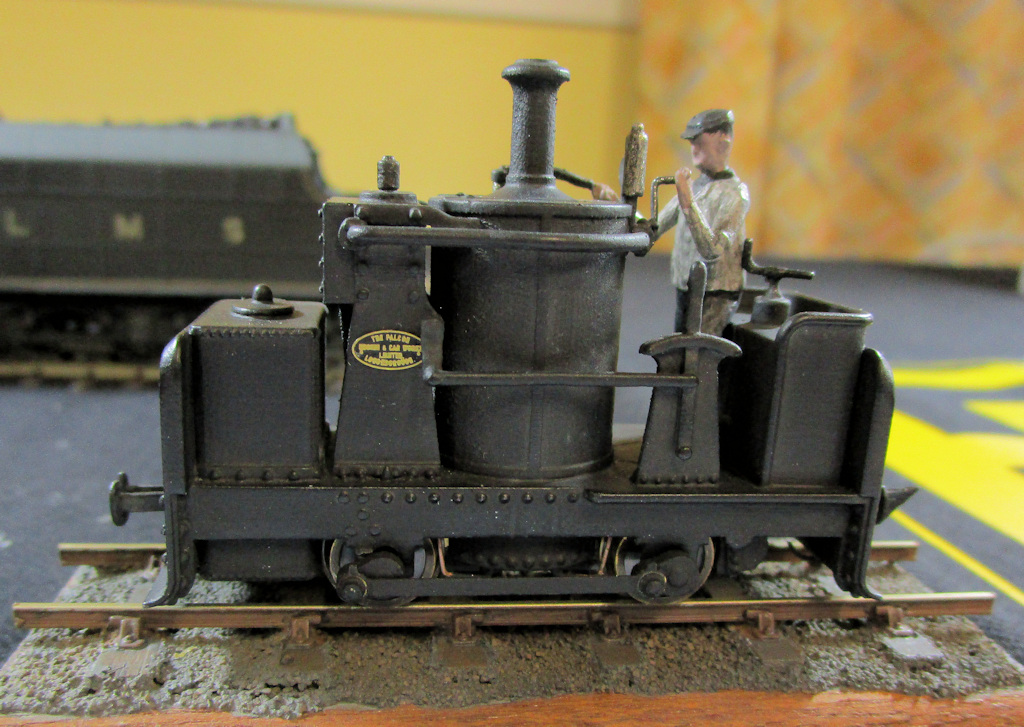 Max Brayne's Falcon Vertical Boiler locomotive was a runner up. This is a 1' 11.5“ gauge 0-4-0 vertical boiler locomotive similar to a De Winton, built by Falcon Engine & Car Works of Loughborough. It worked at the Moel-y-Gest Granite Quarry near Pothmadoc between 1904 and 1906. During this period it was photographed at Porthmadoc Harbour Station on the Festiniog railway. It is possible that the prototype was a De Winton loco of earlier origin that was rebuilt by Falcon and resold with their plates. The 5.5mm scale 12mm gauge model was 3D printed by Shapeways in their 'Frosted Detail' material to Max’s own 3D design created from a drawing and prototype photo. It runs on a custom etched brass chassis from Narrow Planet to his specification with a gearbox from KB scale and a Mashima motor. The custom works plates are also by Narrow Planet. the driver is a white metal figure from Malcolm Savage Models which was printed to match the driver in the prototype photo. The loco is DCC fitted.
Max Brayne's Falcon Vertical Boiler locomotive was a runner up. This is a 1' 11.5“ gauge 0-4-0 vertical boiler locomotive similar to a De Winton, built by Falcon Engine & Car Works of Loughborough. It worked at the Moel-y-Gest Granite Quarry near Pothmadoc between 1904 and 1906. During this period it was photographed at Porthmadoc Harbour Station on the Festiniog railway. It is possible that the prototype was a De Winton loco of earlier origin that was rebuilt by Falcon and resold with their plates. The 5.5mm scale 12mm gauge model was 3D printed by Shapeways in their 'Frosted Detail' material to Max’s own 3D design created from a drawing and prototype photo. It runs on a custom etched brass chassis from Narrow Planet to his specification with a gearbox from KB scale and a Mashima motor. The custom works plates are also by Narrow Planet. the driver is a white metal figure from Malcolm Savage Models which was printed to match the driver in the prototype photo. The loco is DCC fitted.
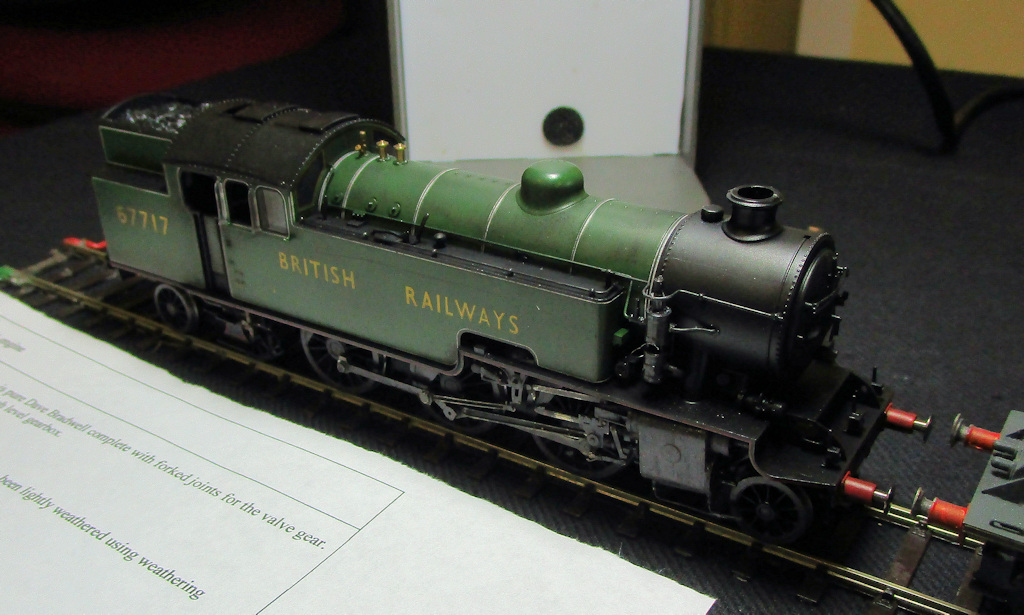 Phil Baxendale's LNER L1 2-6-4 Tank Engine was another runner up. This model has been built to P4 standards. The chassis is pure Dave Bradwell complete with forked joints for the valve gear and it is full springing throughout. A Mashima 1224 motor is coupled to a 40:1 High Level gearbox to provide the power. The body is Hornby, which is one of their better products, and it has been lightly weathered using weathering powders only.
Phil Baxendale's LNER L1 2-6-4 Tank Engine was another runner up. This model has been built to P4 standards. The chassis is pure Dave Bradwell complete with forked joints for the valve gear and it is full springing throughout. A Mashima 1224 motor is coupled to a 40:1 High Level gearbox to provide the power. The body is Hornby, which is one of their better products, and it has been lightly weathered using weathering powders only.
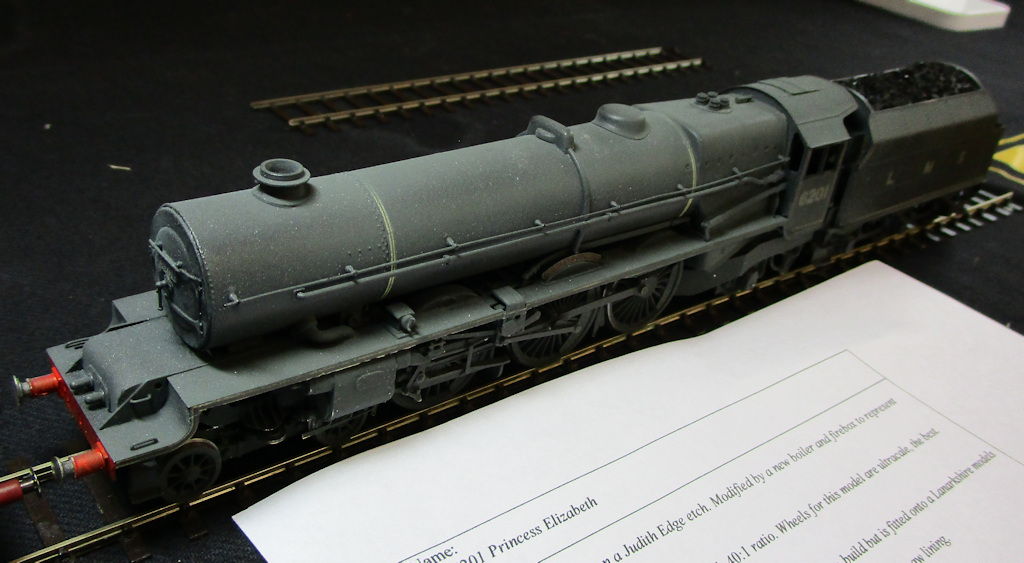 Phil Baxendale's LMS 4-6-2 6201 Princess Elizabeth was a further entry. This model has been built to P4 standards based on a Judith Edge etch. The body has been modified with a new boiler and firebox to represent the loco in 1947 just post war. The loco chassis uses a Mashima 1220 motor with a 40:1 ratio gearbox. Wheels for this model are Ultrascale; all driving wheels are sprung as is the front bogie, which is a Masokits type. The tender is a Comet body, simple, quick and accurate to build but is fitted on to a Lanarkshire Models chassis which provides more detail and is sprung. It is depicted in the then LMS black colour scheme with red and straw lining.
Phil Baxendale's LMS 4-6-2 6201 Princess Elizabeth was a further entry. This model has been built to P4 standards based on a Judith Edge etch. The body has been modified with a new boiler and firebox to represent the loco in 1947 just post war. The loco chassis uses a Mashima 1220 motor with a 40:1 ratio gearbox. Wheels for this model are Ultrascale; all driving wheels are sprung as is the front bogie, which is a Masokits type. The tender is a Comet body, simple, quick and accurate to build but is fitted on to a Lanarkshire Models chassis which provides more detail and is sprung. It is depicted in the then LMS black colour scheme with red and straw lining.
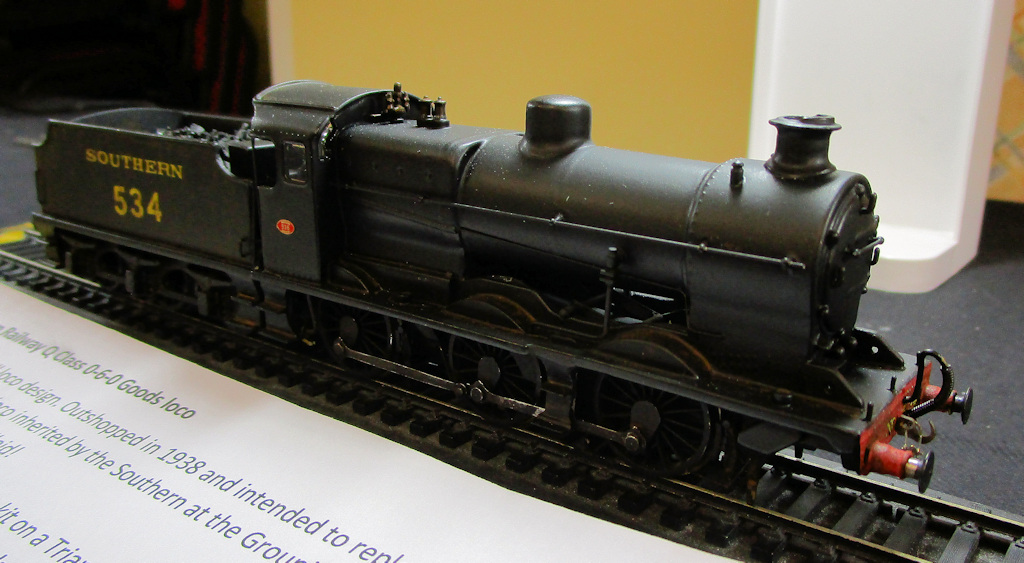 Roy Norton's Southern Railway Q Class 0-6-0 Goods Loco was the final entry in this category. This is the last Maunsell loco design which was outshopped in 1938 and was intended to replace aging pre-group goods loco inherited by the Southern at the Grouping. Pre-grouping locomotives were not a favourite of the new CME, Bulleid. The model is to 4mm 00 scale. Originally it was built from a Wills kit mounted on a Triang chassis. The loco was disassembled with the help of some caustic soda and rebuilt with enhanced detail and it now runs on a Bachmann chassis.
Roy Norton's Southern Railway Q Class 0-6-0 Goods Loco was the final entry in this category. This is the last Maunsell loco design which was outshopped in 1938 and was intended to replace aging pre-group goods loco inherited by the Southern at the Grouping. Pre-grouping locomotives were not a favourite of the new CME, Bulleid. The model is to 4mm 00 scale. Originally it was built from a Wills kit mounted on a Triang chassis. The loco was disassembled with the help of some caustic soda and rebuilt with enhanced detail and it now runs on a Bachmann chassis.
Coaching Stock and NPCS
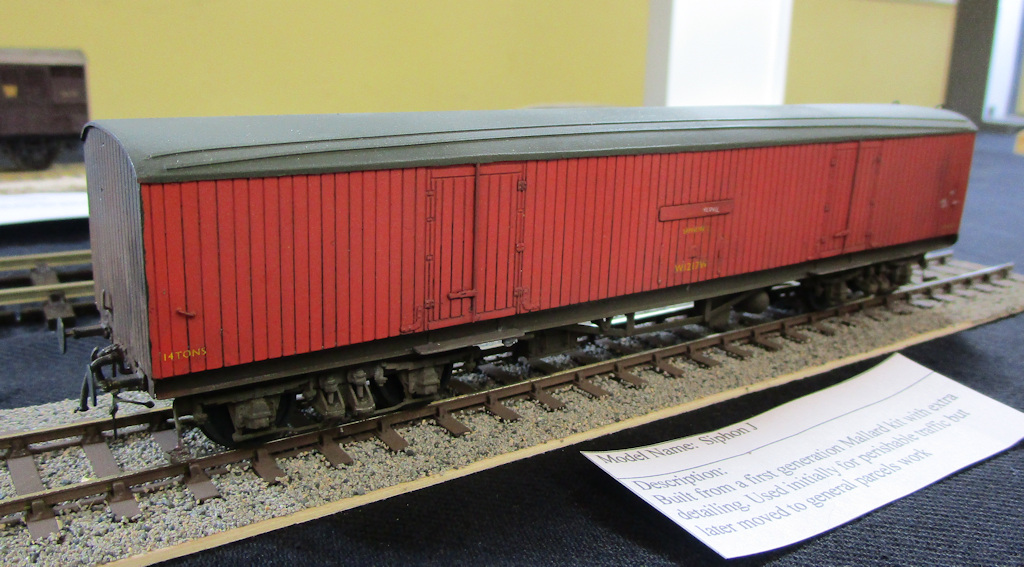 The winner of the Coaching Stock and NPCS competition was Tim Peacock for his Siphon J. These vans were used initially for perishable traffic but later they were moved to general parcels work. The model has been built from a first generation Mallard kit with extra detailing.
The winner of the Coaching Stock and NPCS competition was Tim Peacock for his Siphon J. These vans were used initially for perishable traffic but later they were moved to general parcels work. The model has been built from a first generation Mallard kit with extra detailing.
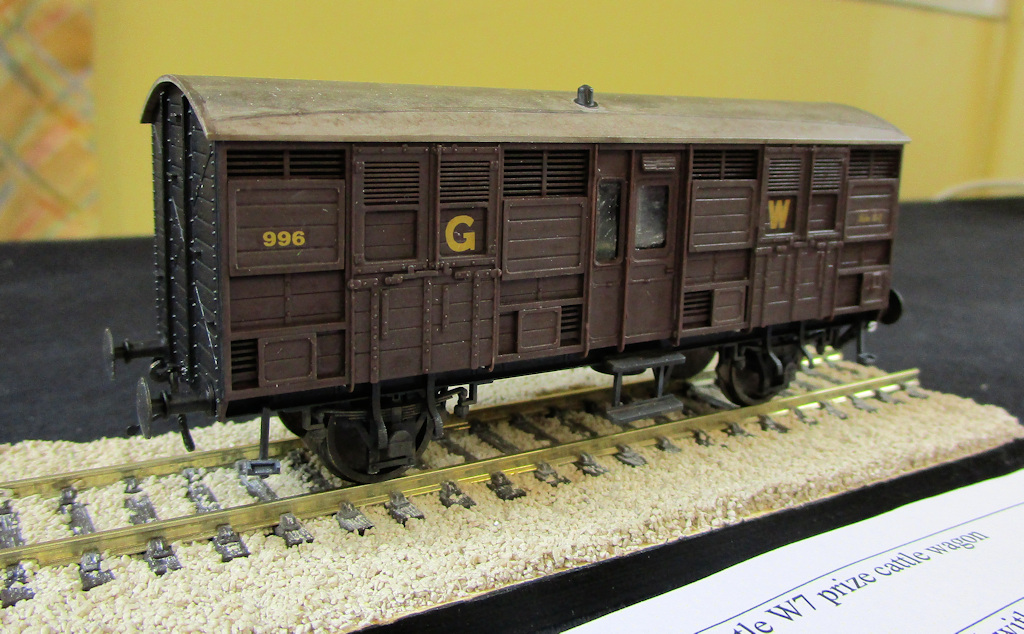 The runner up was Paul Wright's GWR Beetle W7 Prize Cattle Wagon. This has been built from a Parkside kit finished with acrylics and weathering powders. The thing on the roof is the water tank filler. Couplings are from MJT and transfers from Modelmasters.
The runner up was Paul Wright's GWR Beetle W7 Prize Cattle Wagon. This has been built from a Parkside kit finished with acrylics and weathering powders. The thing on the roof is the water tank filler. Couplings are from MJT and transfers from Modelmasters.
Freight and Engineers Stock
As noted under the Wheeltapper Trophy above, James Aitken’s 7mm/ft O gauge model of SR Standard Van with uneven planks was also the winner of the Freight and Engineers Stock category.
Here are more entries from James Aitken. These are SR 5 plank diagram 1380 Opens with 9' underframes. They are scratch built using home designed 3D parts (14 per wagon) - axle boxes, brake shoes, buffer housings and brake lever guides. The bodies are in 1.Smm plastic designed in CAD and cut on the club laser cutter. The strapping is in 0.Smm and the underframe in 0.8mm. The brake gear and W irons are in 1mm. Commercial wheels and buffer heads. Even the 3 link couplings have been hand made. Real coal on extruded polystyrene bases was used to create the loads which can be removed.
Ian Gearing's 5 x Unfitted Grampus. Built from a Parkside kits which have been painted and weathered using acrylics.
Ian Gearing's Crocodiles. Two Scorpio kits which have been painted and weathered with acrylics. Custom Transfers from Railtec.
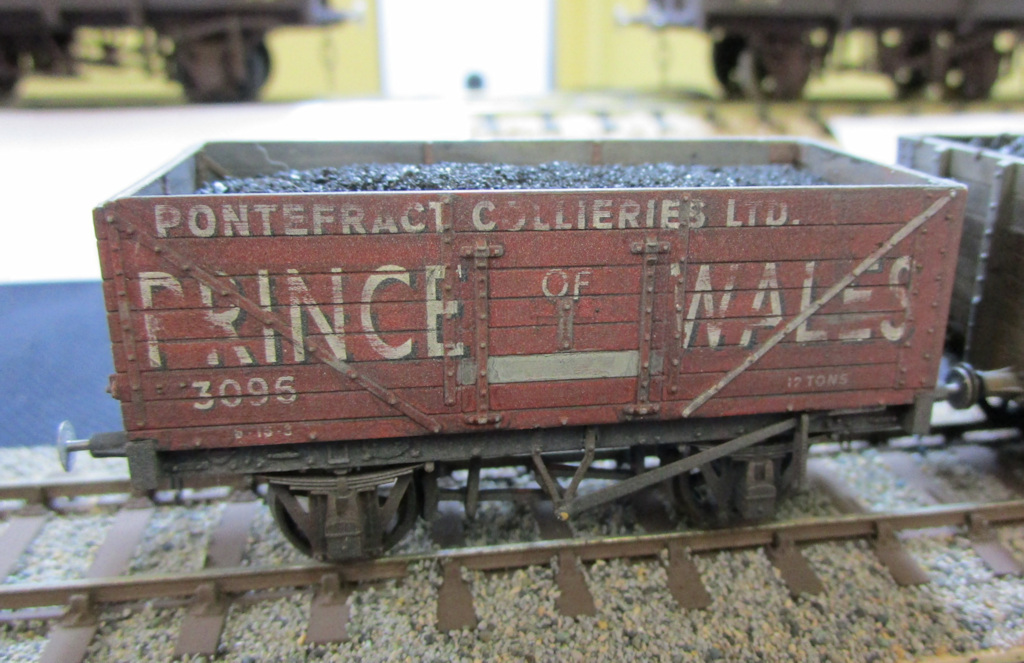

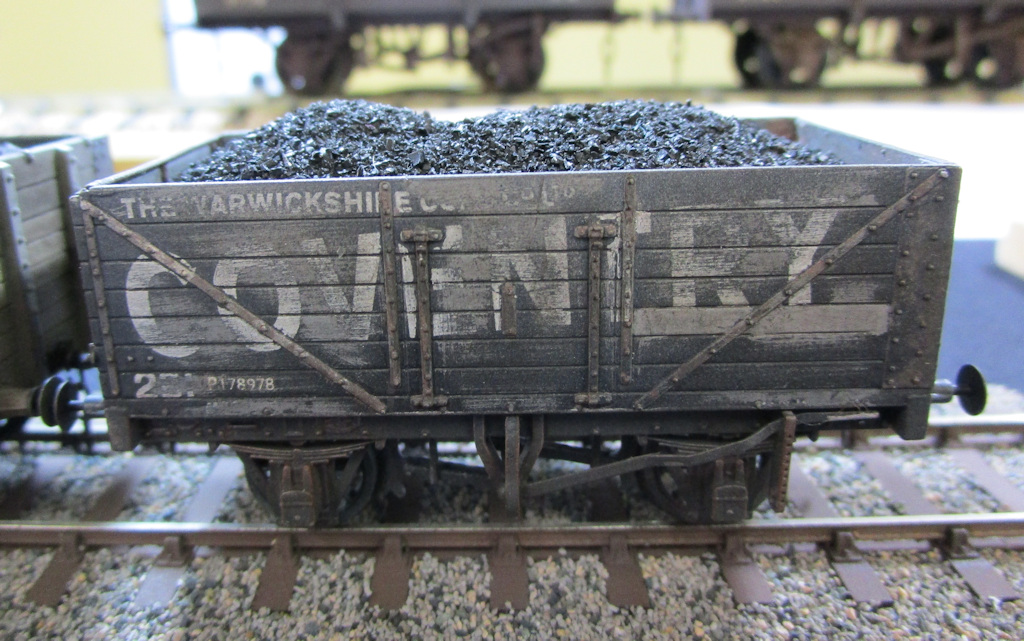 Tim Peacock's Coal Wagons. Two of these are Parkside kits and one is from Bachmann. All three have been heavily weathered with washes and powders, have distressed paintwork and have been given BR numbers.
Tim Peacock's Coal Wagons. Two of these are Parkside kits and one is from Bachmann. All three have been heavily weathered with washes and powders, have distressed paintwork and have been given BR numbers.
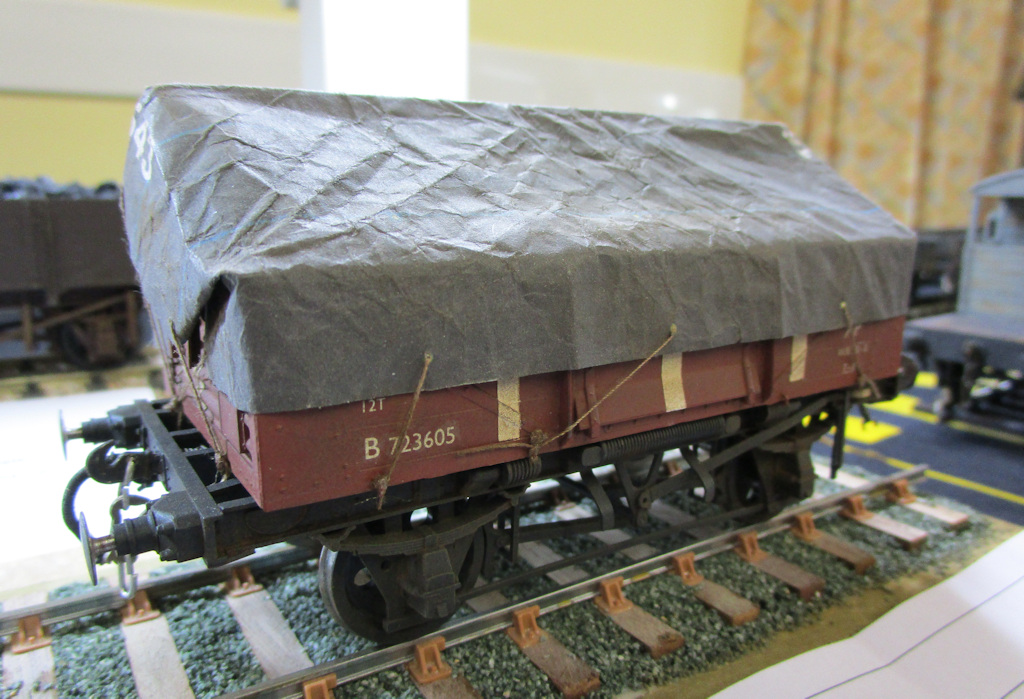 Rob Thompson's BR 12T Shock Absorbing Open Wagon (dia 1/048) number B723605. This is a standard Slaters kit (7060) built to ScaleSeven standards with S7 wheels and brakes properly lined up to the wheels. These wagons are basically as LMS versions but built under BR auspices and give BR diagram, nos. with this one built at Derby in 1954. The livery represents the period 1954-1964.
This is a hybar version and is fitted with a load and has been weathered mildly. As so happened on many shock wagons stripes indicating such are very varied and this has been replicated on this model. It has also been fitted with Instanter couplings. The scale is 7mm to 1ft and is on track gauge at 33mm.
Rob Thompson's BR 12T Shock Absorbing Open Wagon (dia 1/048) number B723605. This is a standard Slaters kit (7060) built to ScaleSeven standards with S7 wheels and brakes properly lined up to the wheels. These wagons are basically as LMS versions but built under BR auspices and give BR diagram, nos. with this one built at Derby in 1954. The livery represents the period 1954-1964.
This is a hybar version and is fitted with a load and has been weathered mildly. As so happened on many shock wagons stripes indicating such are very varied and this has been replicated on this model. It has also been fitted with Instanter couplings. The scale is 7mm to 1ft and is on track gauge at 33mm.
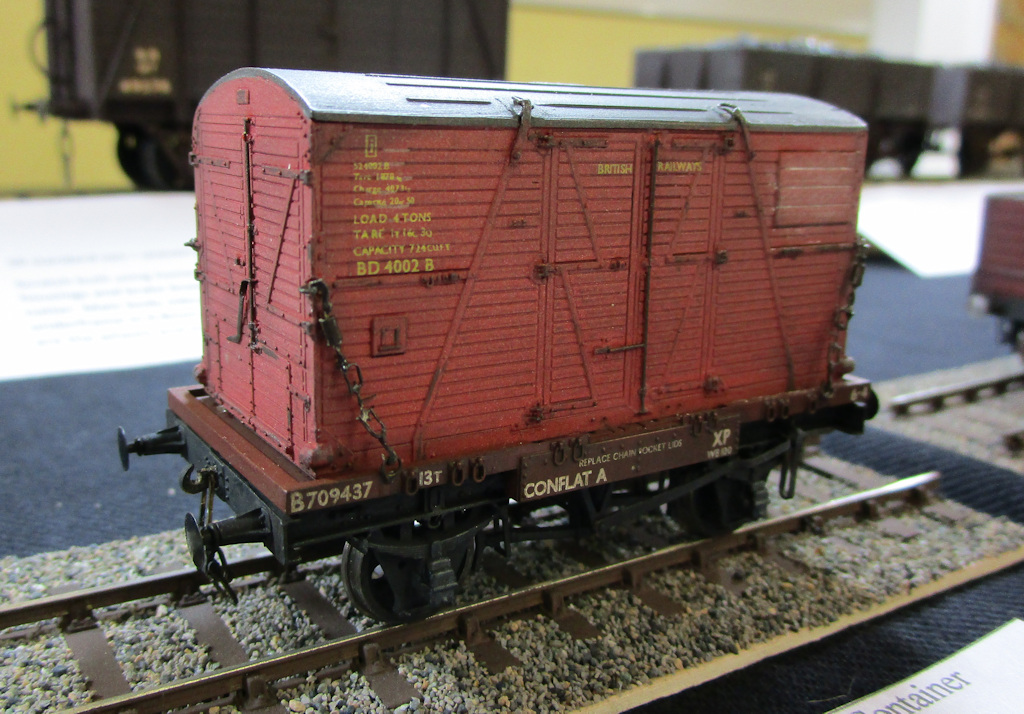 Tim Peacock's BR Conflat and Container. This is a Parkside container on a Bachmann wagon. It has detailed brake gear with securing chains from Ambis - which are a real fiddle! It has been weathered with washes and powders. The Transfers are from Cambridge Custom Transfers.
Tim Peacock's BR Conflat and Container. This is a Parkside container on a Bachmann wagon. It has detailed brake gear with securing chains from Ambis - which are a real fiddle! It has been weathered with washes and powders. The Transfers are from Cambridge Custom Transfers.
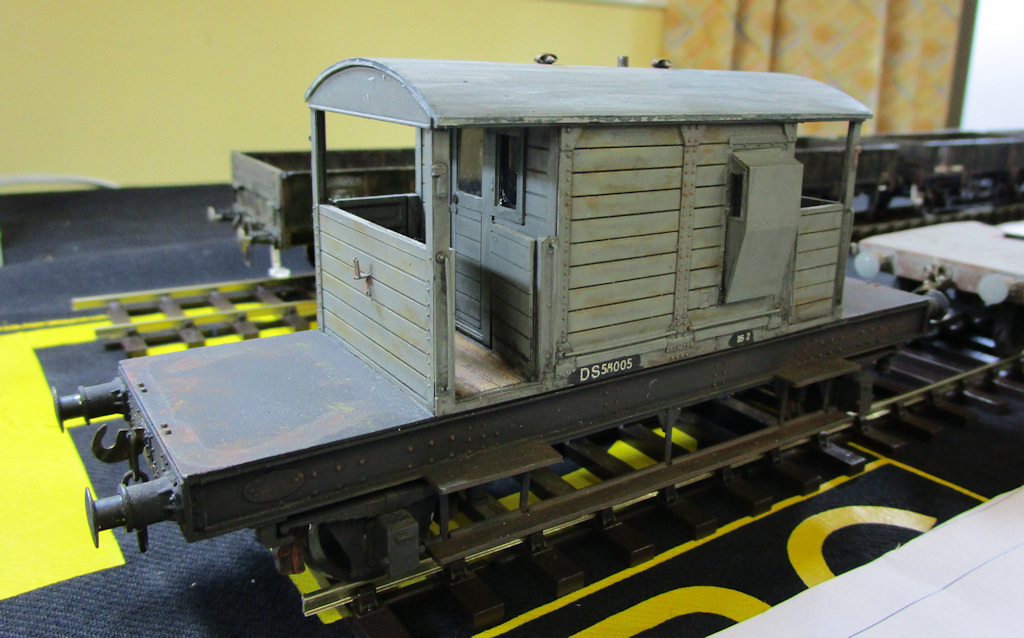 Ian Gearing's SR Brake Van. This is a Parkside Dundas kit which has been painted and weathered with acrylics.
Ian Gearing's SR Brake Van. This is a Parkside Dundas kit which has been painted and weathered with acrylics.
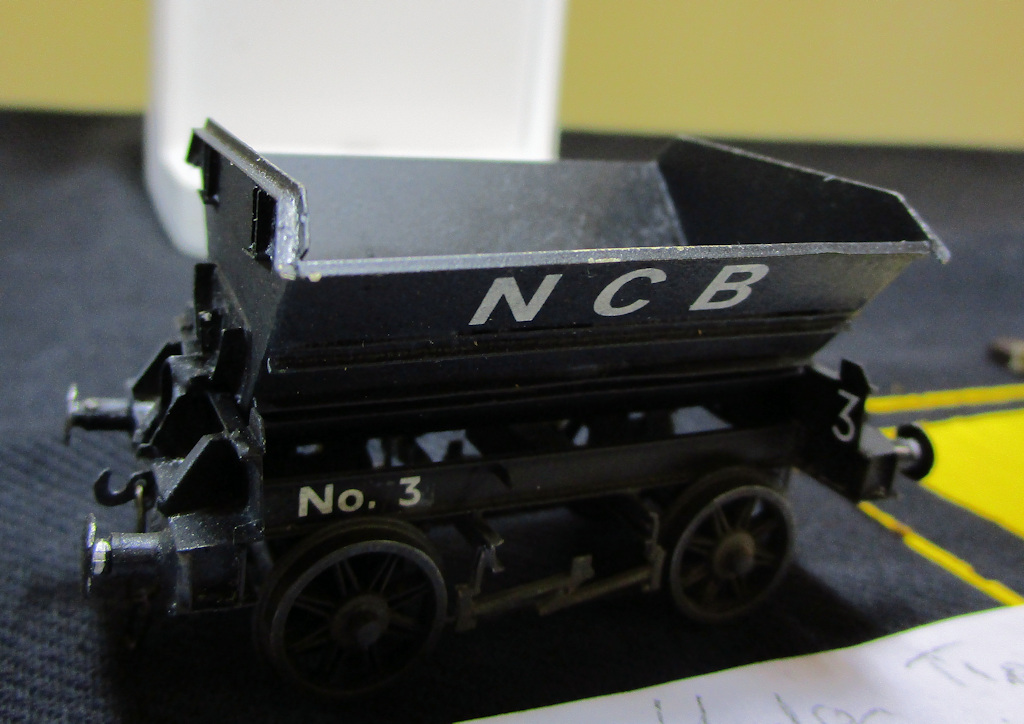 Graham Bucknell's Hudson Tipper. A 4mm/EM gauge model built from a Nickel Silver kit.
Graham Bucknell's Hudson Tipper. A 4mm/EM gauge model built from a Nickel Silver kit.
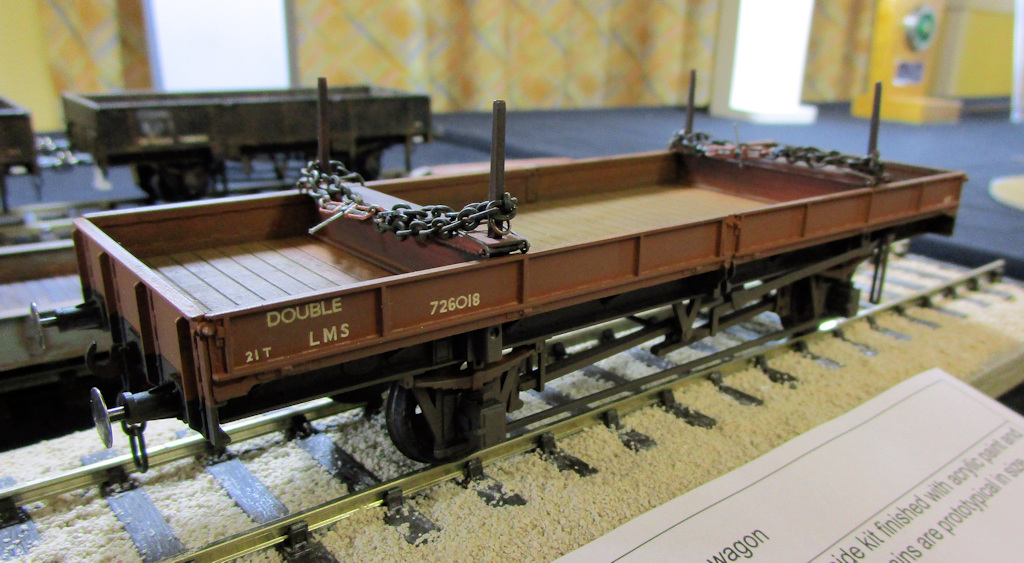 Paul Wright's LMS Double Bolster Wagon. This has been built from a Parkside kit finished with acrylic paint and weathering powders. The large chains are prototypical in size.
Paul Wright's LMS Double Bolster Wagon. This has been built from a Parkside kit finished with acrylic paint and weathering powders. The large chains are prototypical in size.
Road Vehicles, Boats, People, Animals etc
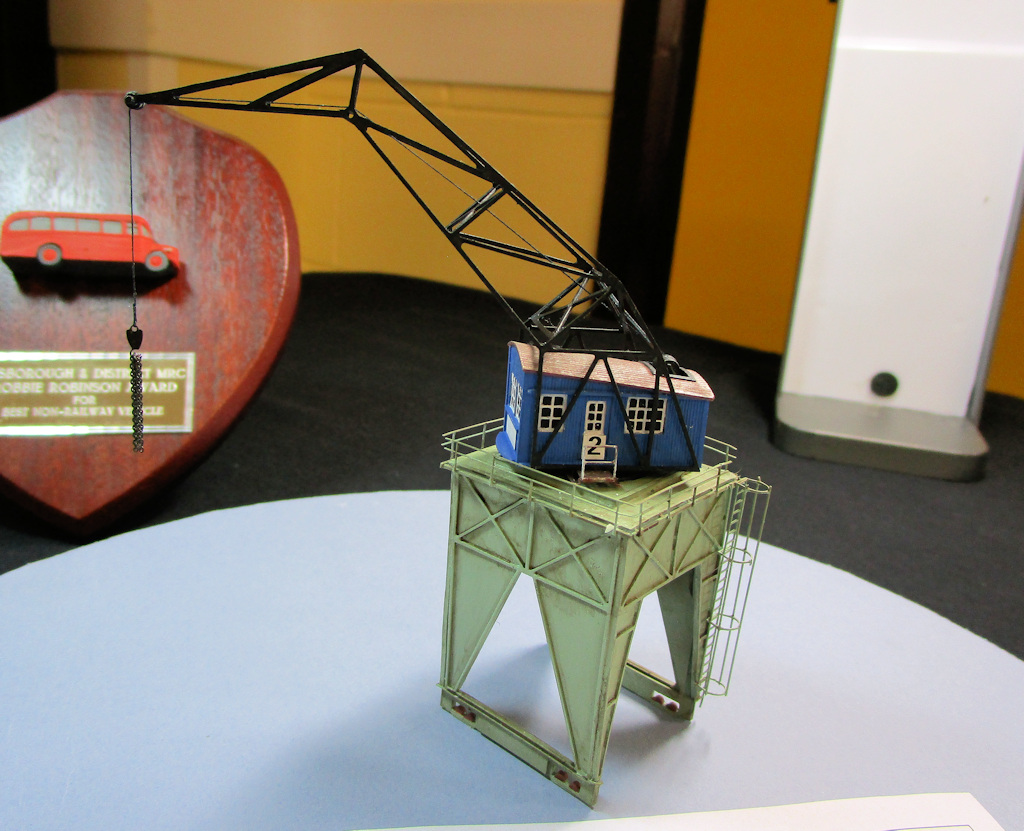 The winner of The Robbie Robinson Award for road vehicles, boats, people, and animals was Paul Wright for his Dock Crane. This has been built from an Artitec resin, machined polystyrene and etched brass kit, painted in acrylics. Stainless steel balls have been added to the underside to provide stability. The cotton thread is painted with very dilute PVA to keep it straight. The number transfers are from kleiNSpoor. The name of the harbour (and station) will be added to the front when Paul has thought of one!
The winner of The Robbie Robinson Award for road vehicles, boats, people, and animals was Paul Wright for his Dock Crane. This has been built from an Artitec resin, machined polystyrene and etched brass kit, painted in acrylics. Stainless steel balls have been added to the underside to provide stability. The cotton thread is painted with very dilute PVA to keep it straight. The number transfers are from kleiNSpoor. The name of the harbour (and station) will be added to the front when Paul has thought of one!
Scenic Models: Buildings, Trees, Signals etc
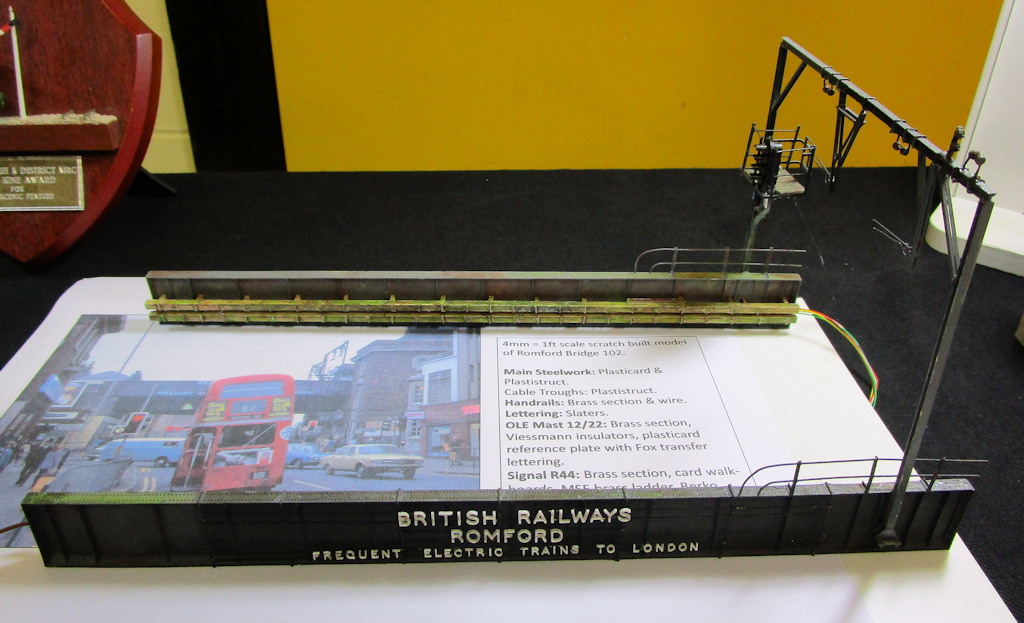 The winner of the Jack Cline Trophy for Scenic Models: Buildings, Trees and Signals was Gary Day for his Romford Bridge 102. This is a 4mm = 1ft scratch built model. The main Steelwork is from plasticard & plastistruct, with plastistruct cable troughs. The handrails are from brass section & wire. The lettering is from Slaters. OLE Mast 12/22 is from brass section with Viessmann insulators, a plasticard reference plate and Fox Transfer lettering, Signal R44 is from brass section with card walk-boards, MSE brass ladder and a Berko signal head.
The winner of the Jack Cline Trophy for Scenic Models: Buildings, Trees and Signals was Gary Day for his Romford Bridge 102. This is a 4mm = 1ft scratch built model. The main Steelwork is from plasticard & plastistruct, with plastistruct cable troughs. The handrails are from brass section & wire. The lettering is from Slaters. OLE Mast 12/22 is from brass section with Viessmann insulators, a plasticard reference plate and Fox Transfer lettering, Signal R44 is from brass section with card walk-boards, MSE brass ladder and a Berko signal head.
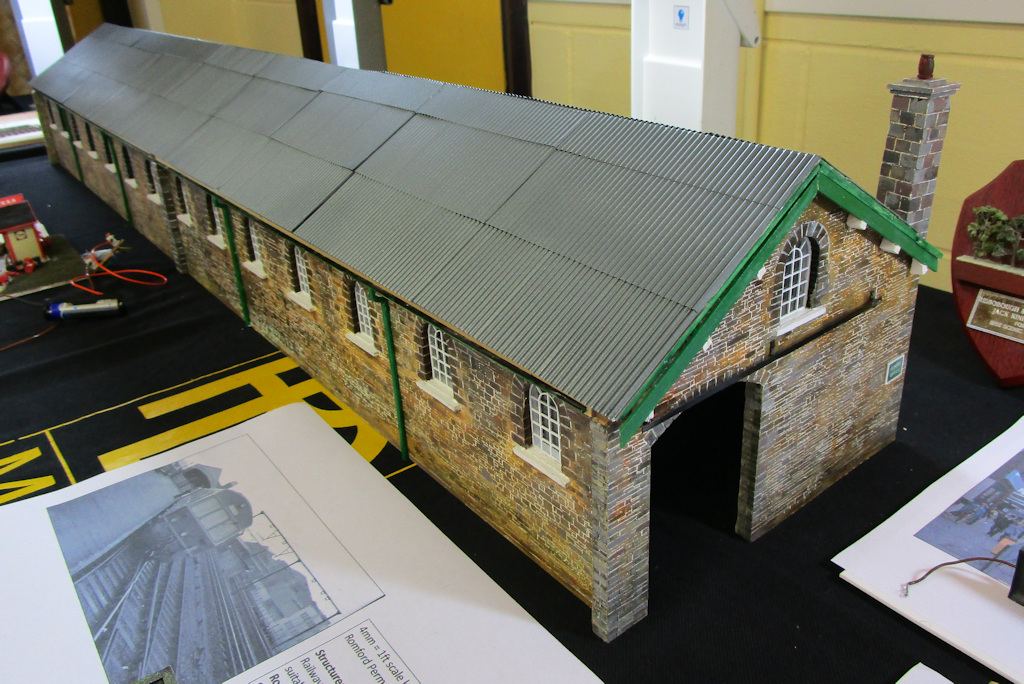 Another entry was Adrian Harford's Okehampton Goods Shed. The model is scratch built (although window frames were laser cut externally before the club purchased it's own), and Ambis 'corrugated iron panels' were purchased for the roof. The main structure consists of MDF panels which were laser etched from heavily edited (or Photoshopped!) modern photographs of the building (now a Youth Hostel). This replicated the random stone work of the original building, which were then painted by an artistic family member, with the ability to represent the variety of colours in the original stones.
A late change of specification mandated that the roof be made removable so that wagons could be retrieved from the track inside in the event of a derailment. The structure is presently in units for ease of development, but will be permanently embedded in the layout in due course. The road side of the building has not been completely developed as it is close to the rear of the layout and not visible to the viewer.
Another entry was Adrian Harford's Okehampton Goods Shed. The model is scratch built (although window frames were laser cut externally before the club purchased it's own), and Ambis 'corrugated iron panels' were purchased for the roof. The main structure consists of MDF panels which were laser etched from heavily edited (or Photoshopped!) modern photographs of the building (now a Youth Hostel). This replicated the random stone work of the original building, which were then painted by an artistic family member, with the ability to represent the variety of colours in the original stones.
A late change of specification mandated that the roof be made removable so that wagons could be retrieved from the track inside in the event of a derailment. The structure is presently in units for ease of development, but will be permanently embedded in the layout in due course. The road side of the building has not been completely developed as it is close to the rear of the layout and not visible to the viewer.
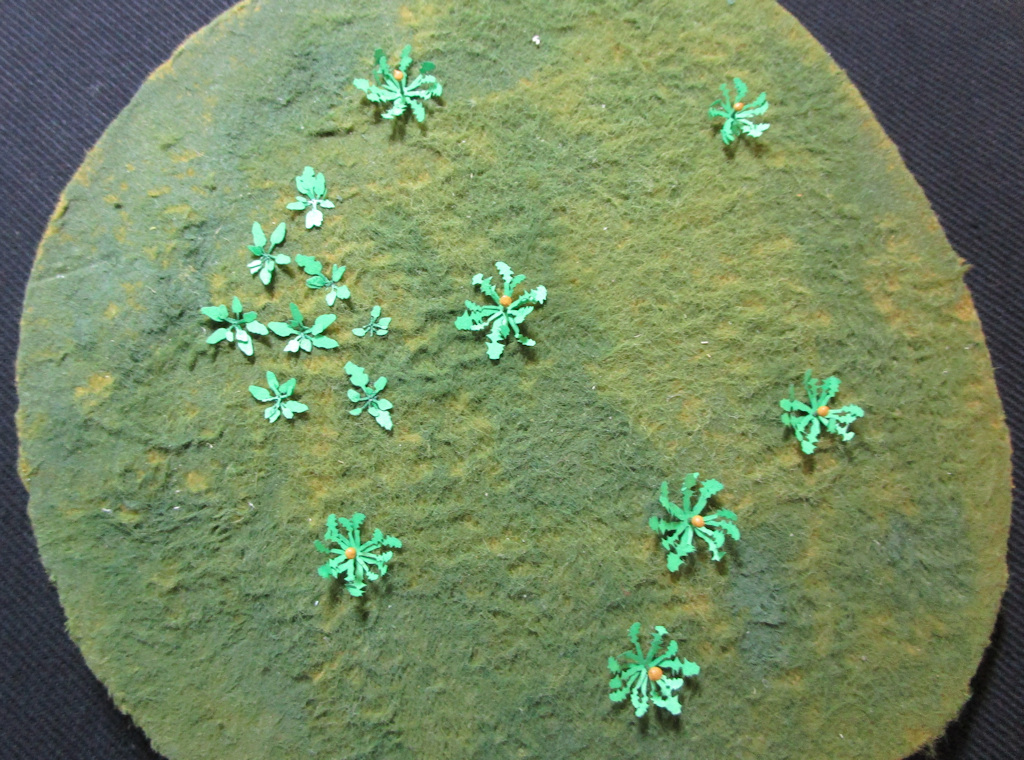 Paul Wright's O Gauge Plants. This is the first batch of self-produced laser cut plants in 7mm scale for Okehampton. They are dandelions. and broad leaf docks. These have been drawn in TurboCad by tracing photos of real leaves and cut from green paper on the club's laser cutter. The dandelion heads are Peco track pins painted with a Games Workshop think yellow paint. While they look a little crude when viewed individually and close up, they do look very effective as part of the scenery giving more colour and texture to the hedgerow.
Paul Wright's O Gauge Plants. This is the first batch of self-produced laser cut plants in 7mm scale for Okehampton. They are dandelions. and broad leaf docks. These have been drawn in TurboCad by tracing photos of real leaves and cut from green paper on the club's laser cutter. The dandelion heads are Peco track pins painted with a Games Workshop think yellow paint. While they look a little crude when viewed individually and close up, they do look very effective as part of the scenery giving more colour and texture to the hedgerow.
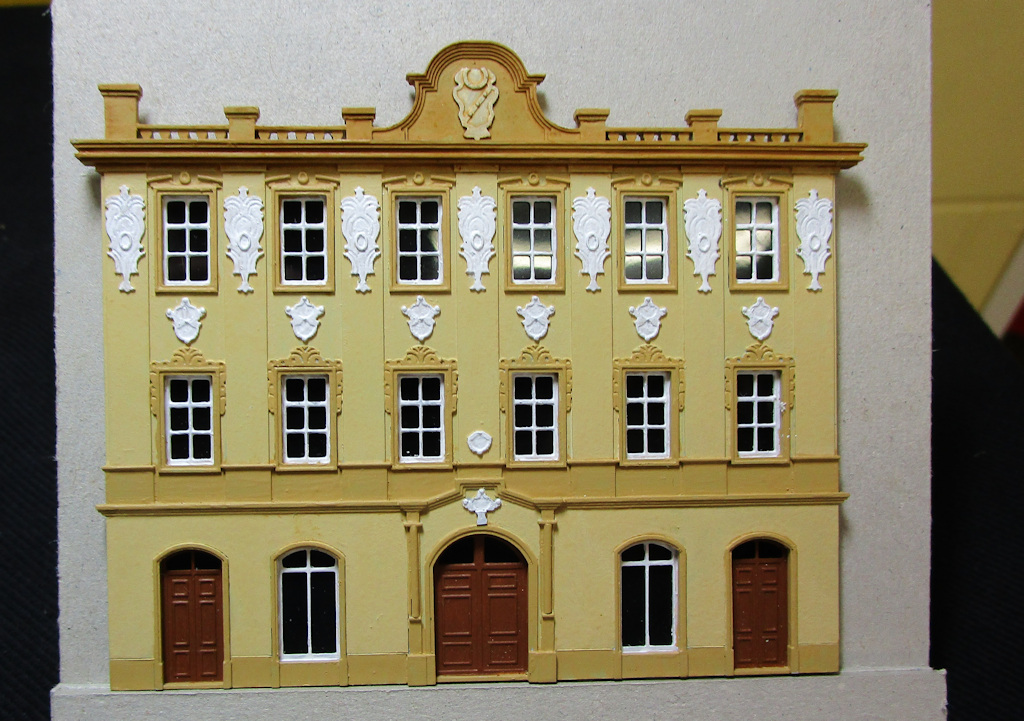 Paul Wright's Dutch Building Facia. This is a resin moulding from Dutch manufacturer Artitec painted in acrylics. These castings have needed to be flattened by putting them in hot water but otherwise it was just a case of having a small paint brush and a steady hand.
Paul Wright's Dutch Building Facia. This is a resin moulding from Dutch manufacturer Artitec painted in acrylics. These castings have needed to be flattened by putting them in hot water but otherwise it was just a case of having a small paint brush and a steady hand.
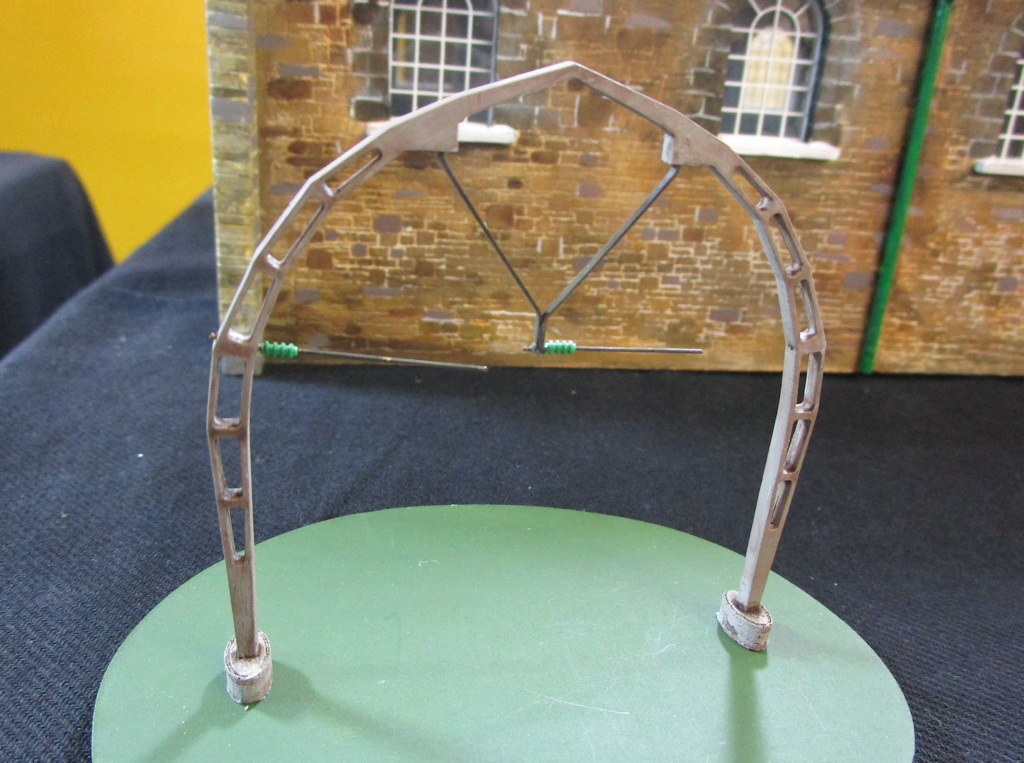 Paul Wright's Dutch Concrete Catenary Mast. The main frame is made from 3 layers of 0.8mm ply that was laser cut by Hogos Finest in Germany. The metalwork is brass rod and isolators are from Sommerfeldt. This is the second of these masts that Paul has built and he says that if he needs any more he will use the Club's laser cutter to produce his own.
Paul Wright's Dutch Concrete Catenary Mast. The main frame is made from 3 layers of 0.8mm ply that was laser cut by Hogos Finest in Germany. The metalwork is brass rod and isolators are from Sommerfeldt. This is the second of these masts that Paul has built and he says that if he needs any more he will use the Club's laser cutter to produce his own.
Okehampton 7mm Wagon Project
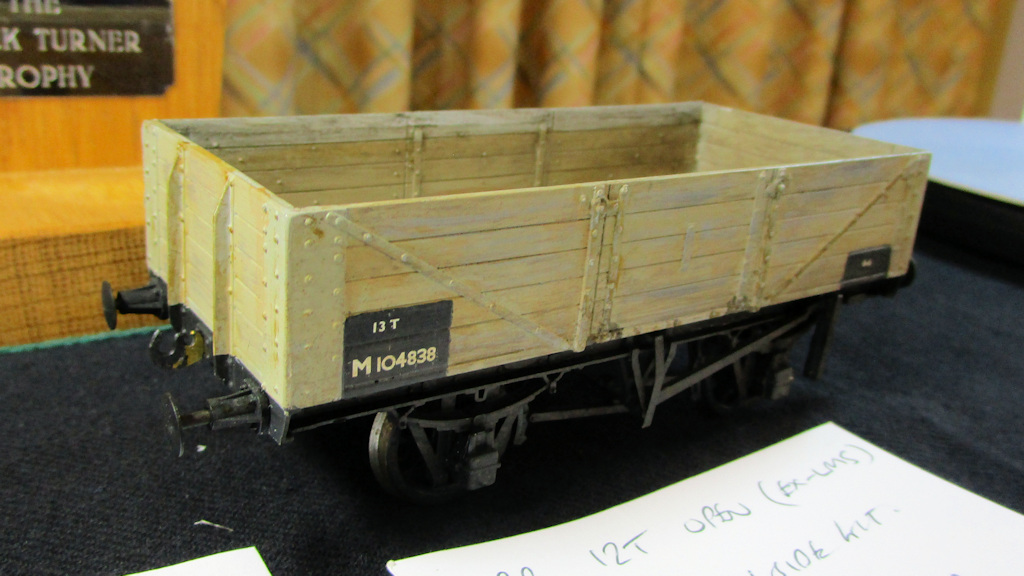 The winner of the Derek Turner Trophy for the Okehampton 7mm Wagon Project was Graham Bucknell for his BR 12T Open Wagon (Ex-LMS). This is a 7mm (O gauge) model of a BR 12T Open Wagon (Ex-LMS) made from a Parkside kit, painted and weathered with acrylics and washes.
The winner of the Derek Turner Trophy for the Okehampton 7mm Wagon Project was Graham Bucknell for his BR 12T Open Wagon (Ex-LMS). This is a 7mm (O gauge) model of a BR 12T Open Wagon (Ex-LMS) made from a Parkside kit, painted and weathered with acrylics and washes.
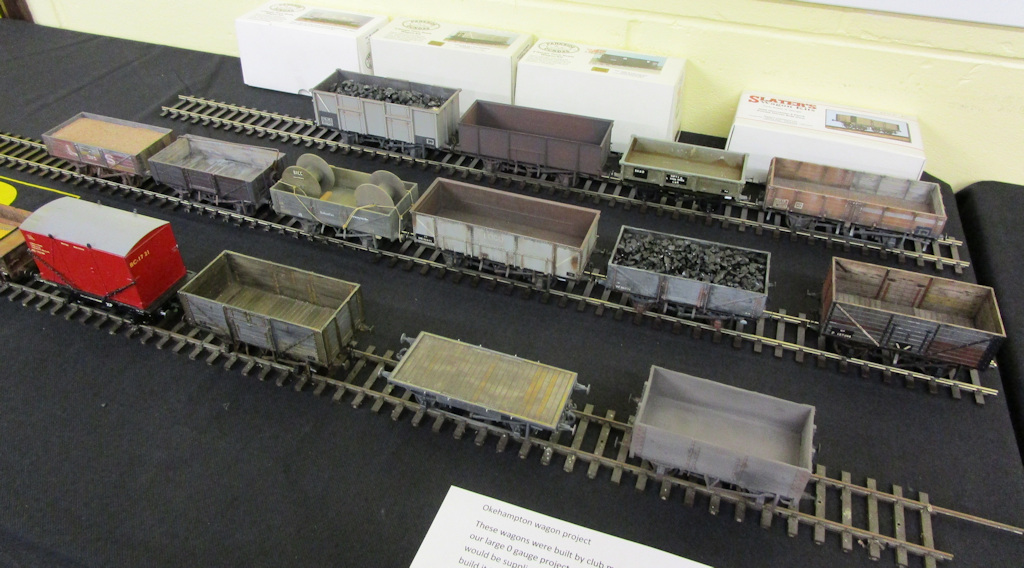 Here is a selection of more wagons that members of the club have produced for Okehampton, the club’s large 0 gauge project. Each member who wanted one was supplied with a Parkside kit for an open wagon, and left to build it in a suitable form for the layout.
Here is a selection of more wagons that members of the club have produced for Okehampton, the club’s large 0 gauge project. Each member who wanted one was supplied with a Parkside kit for an open wagon, and left to build it in a suitable form for the layout.
Aylesbury Town 4mm Model Project
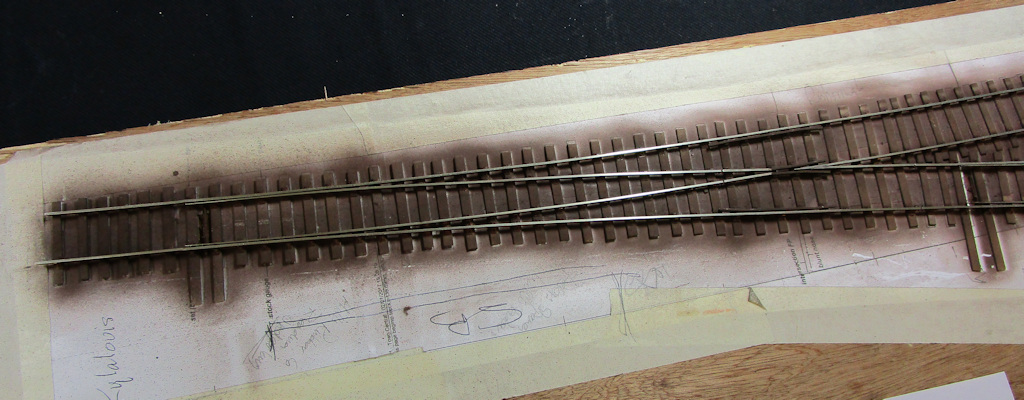
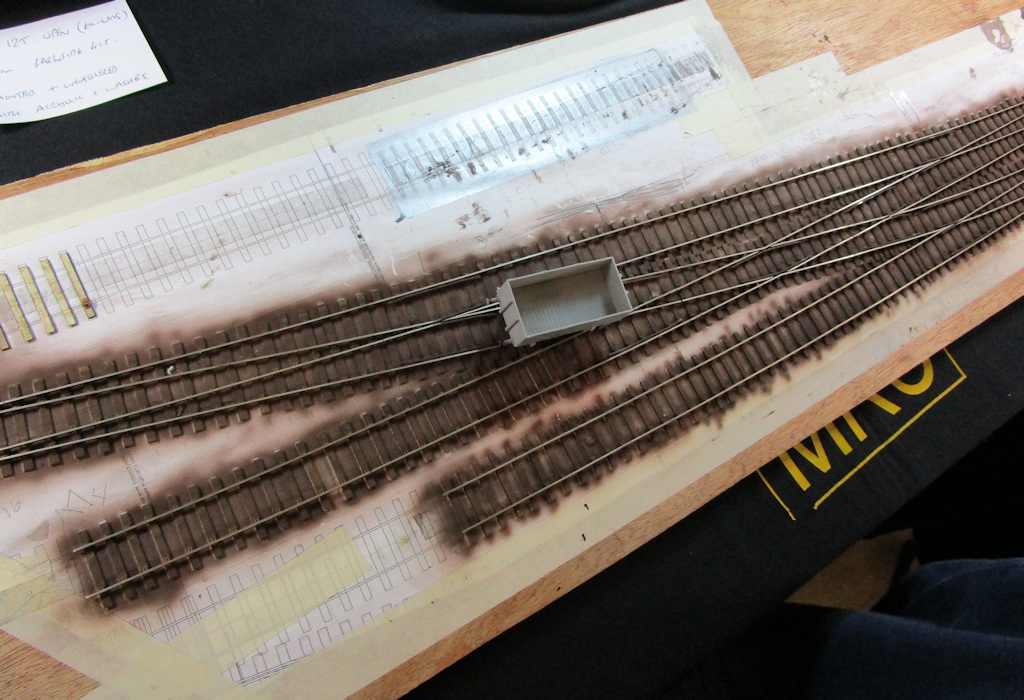
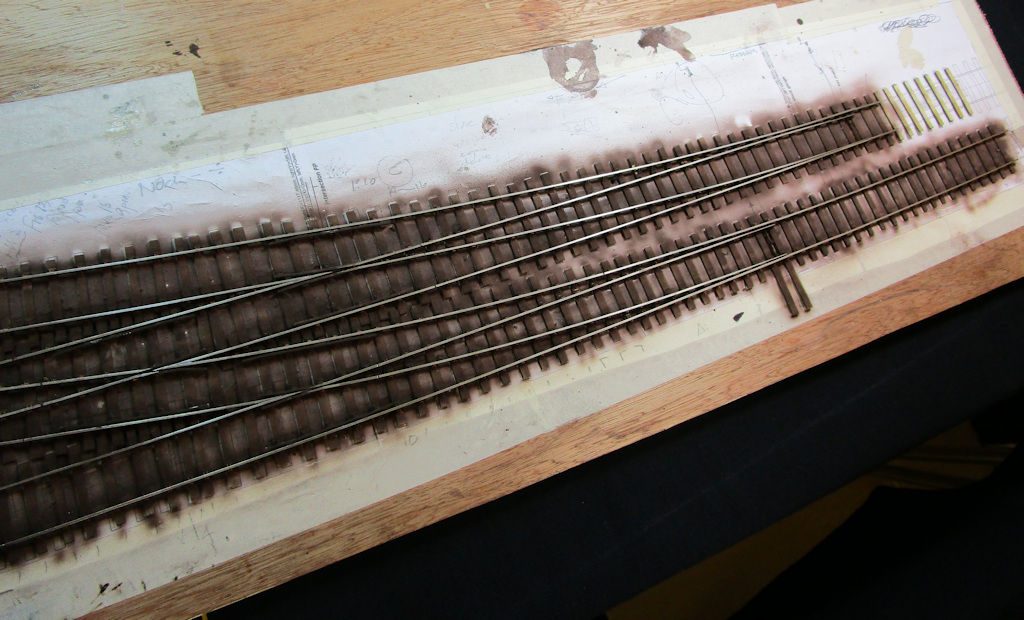 The winner of the Robin Lane Memorial Trophy for the best Aylesbury Town 4mm Model was Phil Baxendale with his Aylesbury Town South Junction Trackwork. The track work is almost ready for laying on the new layout. The tie bars in situ and wire droppers are to be added next. The track has been built from ply sleepers and Exactoscale chairs with hini nickel silver rail pieces cut to length and formed into the crossings, check and wing rails, running rails and point switches. The track has been built on sections of the Templot plan of Aylesbury Town.
The winner of the Robin Lane Memorial Trophy for the best Aylesbury Town 4mm Model was Phil Baxendale with his Aylesbury Town South Junction Trackwork. The track work is almost ready for laying on the new layout. The tie bars in situ and wire droppers are to be added next. The track has been built from ply sleepers and Exactoscale chairs with hini nickel silver rail pieces cut to length and formed into the crossings, check and wing rails, running rails and point switches. The track has been built on sections of the Templot plan of Aylesbury Town.
